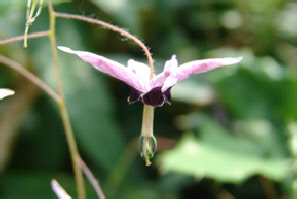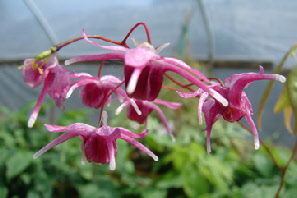
/
Epimedium
Some are very tolerant of dry shade (not all). With the ongoing discovery of many new species, mostly from the mountains of SW China, and a proliferation of nurserymen and breeders selecting and naming new cultivars, there is an ever increasing range of new forms to choose from. They can be deciduous or evergreen, clumping or spreading, in an ever increasing range of colors. There is something for everyone.
Epimediums will not provide the blast of color that some expect in their garden.
Rather they have a delicate wildflower charm that those with a taste for the subtle
and finer points of life are sure to appreciate. This, along with ease of culture,
are making epimediums one of the hottest new groups of plants around. Warning -
Epimediums are all native to temperate woodland situations. There are species in Europe, Japan, Korea, the Caucasus region between the Caspian Sea and the Black Sea, but with the greatest number and diversity coming from China, mostly from the mountains of Sichuan and Yunnan. New species are still being discovered.
CULTURE: In the garden they thrive in well drained, but moisture retentive soil. They do not tolerate wet soil. They are best in light or filtered shade. If the shade is too deep, they will grow, but will have few blooms. They can take some sun, but too much sun and heat will scorch the leaves. While it is true that some are very tolerant of dry shade, and are excellent as a groundcover under shallow rooted trees, this is not true with all species, especially the newer Chinese species. If you are going to cut back all the foliage for a better floral display, it is best to wait until early spring, but be careful that you do this before the new growth has emerged, or you risk cutting off the new with the old.
HARDINESS: Unless indicated otherwise, they have all been proven hardy to zone 5b.
PROPAGATION: Dividing is best done in early spring or late summer into early fall, while they are putting out new roots. They can also be grown from seed. They seem to be self sterile, so if seed is forming, it will most likely be a hybrid. The seed pods and the seed are still green when they fall. Then the ants carry the seeds away, so if you want to collect seed, watch it carefully when the pods start swelling.



Epimedium fargesii ‘Pink Constellation’
Epimedium ‘Pearl Drops’
Epimedium ’Flamingo Dancer’’
Epimediums are some of the most charming, easy going plants that you can plant in shade. They bloom in spring, with small flowers, (2” across is considered large) often with long spurs (again, ‘long’ being a relative term), that dangle gracefully from upright or arching stems. It is not the size of the flowers that matter here, but rather the lovely effect of sometimes up to a hundred flowers on a stem less than 2‘ long, over tidy, dense, weed smothering clumps of foliage that are often dramatically mottled with bronzy red markings in spring and again in fall.

Epimedium lishihchenii





